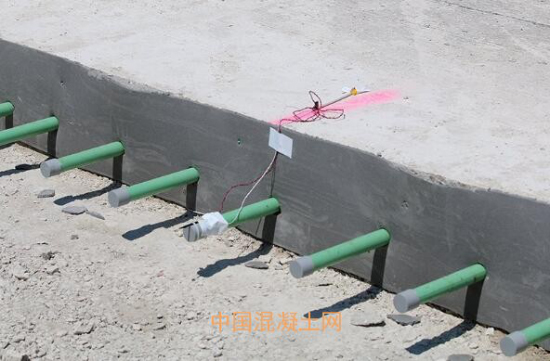The United States embeds sensors into highway concrete to monitor pavement data
Recently, the Indiana Department of Transportation (INDOT) entrusted a team of Purdue engineers to embed sensors into the Indiana highway to more accurately determine when concrete pavements were ready to take on heavy truck traffic, and the data would provide new suggestions to the construction projects about when the roads should be reopened.
The sensor is embedded in the road concrete
It is understood that before the concrete is ready to undertake heavy truck traffic, a construction project has ended, leading to premature road failure and requiring more frequent maintenance throughout the year. To understand exactly how long it takes for concrete to mature on the highway, a team led by Luna Lu, an associate professor at the School of Civil Engineering at Purdue University, is collecting data by the sensors which are designed to measure hydration, stiffness, compressive strength and other nature of concrete to track and monitor changes of concrete strength in real time.
Due to the load and road surface curl and warpage, the concrete pavement must be repaired to a certain level of strength to adapt to truck traffic. With these sensors, the contractor will know exactly when the concrete is mature enough to accommodate heavy truck loads and curl and warp pressures.
At the time of installation, the sensor patch is embedded in the concrete surface and the wires connect the patch to the measurement system. The device uses a so-called piezoelectric effect to convert electrical energy into mechanical energy, thereby exciting the sensor and vibrating the concrete to detect its stiffness. The mechanical energy is then converted back to electrical energy. The sensor measures the reaction of concrete with current flow by reading electrical data to accurately measure the many performance of the concrete at a time.
The data obtained by the sensors helps engineers to more accurately determine
when the road is ready to deal with heavy truck traffic
The team said that although each sensor can only measure 11 inches of concrete area, the cost of embedding many sensors in the concrete section is low. In addition, the sensor with anti-corrosion protection is not easy to be crushed by construction equipment, and can collect data continuously for many years after laying concrete. In contrast, the traditional laboratory test method only collects 28 days of data, and can't test the strength of concrete and other related data for a long time.
In this regard, experts in the Concrete Pavement and Materials Science of the American Concrete Pavement Association commented that the impact of this research may be revolutionary because it does not require any traditional mechanical testing or expensive and cumbersome test setups on site, nor need to calibrate each different hybrid design. Sensors can track and monitor the change trends of concrete strength over a longer period of time, help engineers know if the roads that they have designed are with too high or too low strength and better determine when they should replace the concrete.
Currently, researchers and INDOT engineers have embedded the sensors into three highways in Indiana. In addition, the team worked with the US Federal Highway Administration to conduct pooled fund research nationwide to implement the technology in other states. At present, California, Texas, Kansas, and Missouri have planed to join the study.


